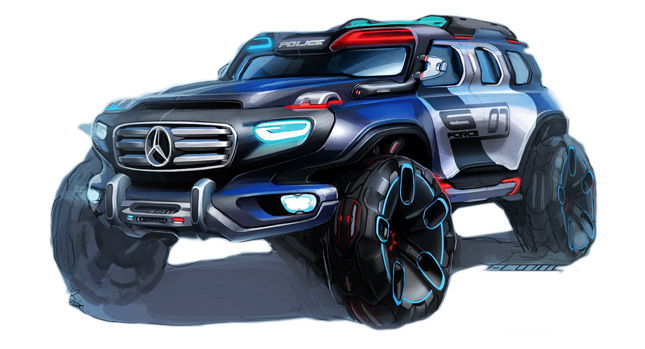Have you pondered what the world will be like in, let’s say, 2025? Predicting the future is nigh impossible but one thing’s for sure: law enforcement agencies are still going to be around in one form or another.
If things turn sour, by 2025 we might very well have a Judge Dredd-like scenario with a police state trying to maintain the law in urban jungles. If, on the other hand, all those wishes for world peace eventually come true, police officers will have a much more relaxing job.
However things play out, said officers will still have need for patrol vehicles. The organizers of the 9th annual LA Auto Show Design Challenge must have thought along the same lines, because this year’s challenge posed to automakers’ designers is to envision the highway patrol vehicles of 2025.
The winner will be announced on November 29 and will be judged on a number of criteria including consideration of needs for advanced technology, speed and agility, creativity and environmental sensitivity (no, citizens’ rights sensitivity isn’t included, in case you were wondering…).
The LA Show Design Challenge Entries are the following:
bmw-e-patrol-1525255b425255d.jpg”> BMW Group DesignWorks USA: Return of the Drones
BMW Group DesignWorks USA: Return of the Drones
The German manufacturer’s U.S. design studio chose a scenario in which it will deploy its E-Patrol (Human-Drone Pursuit Vehicle) in Los Angeles. That’s because their research predicted that by 2025, the City of Angels will have more traffic and faster vehicles powered by alternative fuel sources.
BMW‘s proposal features a two-passenger main structure, one flying and two single wheel drones that can be deployed by the officer seating in the main structure in the case of a pursuit.

 General Motors Advanced Design California: Hey, it’s the Volt Squad
General Motors Advanced Design California: Hey, it’s the Volt Squad
It may sound a bit cheesy, but GM’s vision of patrolling highways in 2025 is a three-vehicle fleet, with each one assuming a clearly defined role based on the concept of OBSERVE, PURSUE and ENGAGE.
The studio says that this allows for superior capability, while the vehicles’ propulsion systems are, you guessed it, based around the VOLT advanced propulsion system.

 Honda R&D Americas, Advanced Design Studio, California: The Drone Squad
Honda R&D Americas, Advanced Design Studio, California: The Drone Squad
Is it just us or are the words “drones” and “squad” getting too common in this article? No matter; Honda’s U.S. Studio’s entry for the competition is the CHP Drone Squad, a vehicle system designed to work in California’s harsh highways with no need for any new infrastructure.
The Auto-Drone operates as a manned or unmanned mission control vehicle from which the Moto-Drones, un-manned motorcycles capable of being equipped for a variety of missions, can be launched in law enforcement or rescue missions.
What’s more, like the best of convertible tops, they can be deployed while the Auto-Drone is on the move.

 Honda R&D Company, Advanced Design Studio, Tokyo: “CHiPs” Reloaded
Honda R&D Company, Advanced Design Studio, Tokyo: “CHiPs” Reloaded
If anyone knows anything about what the world will look like in 2025, he/she is located in the land of the Rising Sun. Stereotypes aside, Honda’s Tokyo-based studio envisioned a scenario in which, despite a period of safe automated “driving”, the California area is becoming challenging as some of its residents resume its past car culture.
(Ed’s note: Actually, that sounds like a very realistic scenario; but let’s move on…)
To that end, they have designed the “CHiPs” 2025 Traffic Crawler, a new patrol vehicle that, according to the company, offers sporty mobility and the toughness required to respond in severe traffic conditions.

 Mercedes-Benz R&D North America, Advanced Design Center California: May the G-Force Be With You
Mercedes-Benz R&D North America, Advanced Design Center California: May the G-Force Be With You
In 2025, ze law enforcement officers vill need to adapt to a more challenging environment: namely, a larger population, even more crowded roads with electronically monitored and controlled traffic and changes in human behavior.
The Mercedes-Benz “Ener-G-Force” is a down-to-earth proposal based on the G-Wagen, the ultra-rugged 4×4 which has been in production since the 1970s and, as the company’s designers believe, will soldier on as a structurally and technologically advanced SUV.

 Subaru Research and Development: SHARCs in Hawaii
Subaru Research and Development: SHARCs in Hawaii
Are you tired of hearing about California and LA? Good, because Subaru’s designers have chosen Hawaii as the region around which their 2025 scenario is based.
The Subaru Highway Automated Response Concept or SHARC patrol vehicles will provide 24-hour eco-friendly and affordable monitoring of the new inter-island Paradise Highway. The zero-emission SHARCs meet Hawaii’s UltraGreen carbon-neutral environmental regulations as they are powered by renewable energy.
Moreover, they operate autonomously, eliminating the need for a full-time highway patrol police force.
There, you have 13 years to enjoy Waikiki as much as you can because, once those SHARCs become self-aware, the countdown to Judgment Day begins…
By Andrew Tsaousis



